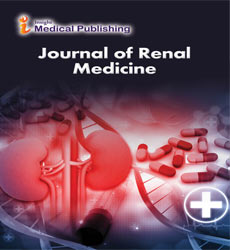Current Insights and Challenges in MPGN, FGN, and PGN Glomerulonephritis
Vanessa Silva*
Department of Genetics, Federal University of Parana, Curitiba, Brazil
- *Corresponding Author:
- Vanessa Silva
Department of Genetics, Federal University of Parana, Curitiba,
Brazil,
E-mail: silvav@gmail.com
Received date: June 18, 2024, Manuscript No. IPJRM-24-19504; Editor assigned date: June 21, 2024, PreQC No. IPJRM-24-19504 (PQ); Reviewed date: July 05, 2024, QC No. IPJRM-24-19504; Revised date: July 12, 2024, Manuscript No. IPJRM-24-19504 (R); Published date: July 19, 2024, DOI: 10.36648/ipjrm.7.4.37
Citation: Silva V (2024) Current Insights and Challenges in MPGN, FGN, and PGN Glomerulonephritis. J Ren Med Vol.7 No.4: 37.
Description
Membranoproliferative Glomerulonephritis (MPGN) is at this point not an illness yet an example of injury in different sicknesses. Electron microscopy findings were used to previously classify MPGN as having electron-dense deposits, mesangial proliferation and duplication of the glomerular basement membrane. When complement dysfunction was found in MPGN injury cases, however, our understanding of its pathogenesis was significantly altered. Another characterization, including resistant complex-interceded and supplement intervened MPGN, has become ideal and has been taken on by worldwide rules. Despite these advancements, the precise conclusion of MPGN stays a clinical test, given the neurotic and clinical likenesses between invulnerable complex-intervened and supplement interceded MPGN. Frequently, additional testing, such as genetic and molecular testing is required.
Pediatric Chronic Kindy Disease (CKD)
Rare kidney disease known as Fibrillary Glomerulonephritis (FGN) typically affects middle-aged individuals and frequently presents with advanced renal failure, proteinuria and hypertension. FGN can be related with immune system illnesses, hepatitis C disease and malignancies. Its precise pathogenesis stays subtle, and the particular function of the DnaJ homolog subfamily B part 9 is still up in the air. FGN has distinct, nonbranching, Congo-red-negative, approximately 20 nmdiameter fibrils on renal biopsy. Immunohistochemical staining of DnaJ homolog subfamily B member 9 has emerged as the industry standard for diagnosis. Congophilic, monotypic and crescentic FGN are examples of atypical variants, highlighting the disease's diversity. Immunosuppression, including rituximab, has had varying degrees of success, but no standard treatment has been established. FGN frequently progresses to end-stage kidney disease, which typically occurs two to four years after diagnosis. Kidney transplantation is a practical choice for FGN-related endstage kidney illness, however repeat in relocated kidneys isn't uncommon. The exact pathophysiology of FGN stays dubious. In any case, there is proof recommending a hereditary inclination to the sickness. First, it appears that the majority of affected individuals in large series are caucasians. Additionally, only a few cases of familial FGN have been reported. In addition, one series revealed a connection between FGN and the HLA-B35 and Human Leukocyte Antigen (HLA)-DR7 antigens.
Pediatric nephrology
It can be difficult and often delayed to diagnose Paraneoplastic Glomerulonephritis (PGN), which can result in significant morbidity and mortality. Paraneoplastic glomerulonephritis, a rare complication of a malignant tumor, results in glomerular lesions that are products of the tumor cells and have nothing to do with tumor burden, invasion, or metastasis. PGN can be the underlying show of Renal Cell Carcinoma (RCC) or an indication of repeat. There have been sporadic reports of a link between ANCA-associated vasculitis and solid tumors, but cancers are frequently discovered after vasculitis is first diagnosed. A 51- year-old male with hypertension and a kidney growth analyzed and investigation of the convention by oncology with gauge creatinine 1.8 mg/dl, family background of RCC, with sickness, looseness of the bowels, unexpected diminishing of pee result and deteriorating in renal capability because of uremic disorder and hyperkalemia, renal substitution treatment was begun. Excluding obstructive and prerenal causes, the approach was carried out. With Rapidly Progressive Glomerulonephritis (RPGN) and serology positive for Perinuclear Antineutrophil Cytoplasmic Antibody (PANCA) and Myeloperoxidase (MPO). A renal biopsy revealed crescentic pauci-immune glomerulonephritis with clear cell RCC and interstitial fibrosis. He is currently being ringed back to reduction acceptance treatment with rituximab, without recuperation of renal capability on hemodialysis multiple times at week. PGN related with RCC is uncommon. Patients who received immunosuppression in addition to cancer-specific therapy had a better outcome than those who received nephrectomy, systemic therapy or immunosuppression alone. Nephrectomy and immunosuppression were used to treat our patient, but kidney function did not improve and vasculitis went into partial remission. Because the course of paraneoplastic glomerulonephritis is difficult to diagnose and treat, early detection and close follow-up may help improve an already complicated prognosis. Given the high dreariness and mortality related with AAV, alongside arranged disease treatment, we would need to treat ANCA-related vasculitis with standard immunosuppression, including steroids and additionally cyclophosphamide or potentially rituximab to forestall irreversible harm of the kidney. A high level of clinical suspicion remains essential for the diagnosis and treatment of PGN in the absence of a diagnostic tool.
Open Access Journals
- Aquaculture & Veterinary Science
- Chemistry & Chemical Sciences
- Clinical Sciences
- Engineering
- General Science
- Genetics & Molecular Biology
- Health Care & Nursing
- Immunology & Microbiology
- Materials Science
- Mathematics & Physics
- Medical Sciences
- Neurology & Psychiatry
- Oncology & Cancer Science
- Pharmaceutical Sciences
